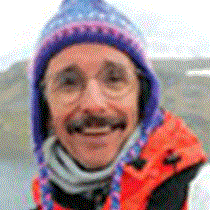LeConte Bay & Petersburg
This is an expedition, not a cruise; an adventure dedicated to learning and education, not entertainment. So in true expedition fashion we donned our raingear, rubber boots and life vests and explored by inflatable Zodiacs the deep blue icebergs of LeConte Bay. John Muir, who explored Alaska many times from 1879 to 1899, described icebergs like these as being not merely blue, but a “startling, chilling, almost shrieking vitriol blue.” We supposed that if we were that cold we’d be blue too.
The current ran strong against the larger bergs, as they lay stranded on the bottom by the low tide, yet we managed to skirt them with relative ease, able to inspect their most alluring faces and moods. Wisps of fog wreathed the shoreline forest while morning brought mist followed by a clearing sky. The icebergs had calved from the nearby LeConte Glacier, the southernmost tidewater glacier in North America, which itself descends from the Sikine Icefield, one of three major icefields in Southeast Alaska. Think of a glacier as a river of ice, and an icefield as a lake of ice—rivers flow, lakes do not. The LeConte—born in the Stikine Icefield and fed by the snow that falls high in the Coast Range every month of the year—descends to sea level and calves its ice into the ocean.
“Man, man, you ought to have been with me,” Muir once exclaimed to a friend who’d not gone exploring with him on a glacier, “You’ll never make up what you lost today. I’ve been wandering through a thousand rooms of God’s crystal temple. I’ve been a thousand feet down in the crevasses, with matchless domes and sculpted figures and carved ice-work all about me... Such purity, such color, such delicate beauty! I was tempted to stay there and feast my soul, and softly freeze, until I would become part of the glacier.” Maybe John Muir was crazy, or maybe he was joyously in love with nature.
By early afternoon we were docked in Petersburg, a hardworking hand-me-a-wrench-and-I’ll-fix-it-myself fishing town where hundreds of boats come and go, and thousands of gulls pinwheel off the pilings as they dip and dive for fish remains next below the canneries, and everybody wears boots and a smile. Some of us went aerial flightseeing over the glaciers; others walked about town to feel authentic Alaska, and still others zipped across Wrangell Narrows by Zodiac to hike through the forest and follow a boardwalk across muskeg where shore pines bent their branches as if in a banzai garden manicured by wind and rain. It couldn’t have been more beautiful.
Our evening meal was a feast—ribs and Dungeness crab with potato salad and more fine wine. Sunset bathed the town in warm light as we pulled away, northbound, and naturalist Kevin Clement told fun stories about Life in the Big Country.
This is an expedition, not a cruise; an adventure dedicated to learning and education, not entertainment. So in true expedition fashion we donned our raingear, rubber boots and life vests and explored by inflatable Zodiacs the deep blue icebergs of LeConte Bay. John Muir, who explored Alaska many times from 1879 to 1899, described icebergs like these as being not merely blue, but a “startling, chilling, almost shrieking vitriol blue.” We supposed that if we were that cold we’d be blue too.
The current ran strong against the larger bergs, as they lay stranded on the bottom by the low tide, yet we managed to skirt them with relative ease, able to inspect their most alluring faces and moods. Wisps of fog wreathed the shoreline forest while morning brought mist followed by a clearing sky. The icebergs had calved from the nearby LeConte Glacier, the southernmost tidewater glacier in North America, which itself descends from the Sikine Icefield, one of three major icefields in Southeast Alaska. Think of a glacier as a river of ice, and an icefield as a lake of ice—rivers flow, lakes do not. The LeConte—born in the Stikine Icefield and fed by the snow that falls high in the Coast Range every month of the year—descends to sea level and calves its ice into the ocean.
“Man, man, you ought to have been with me,” Muir once exclaimed to a friend who’d not gone exploring with him on a glacier, “You’ll never make up what you lost today. I’ve been wandering through a thousand rooms of God’s crystal temple. I’ve been a thousand feet down in the crevasses, with matchless domes and sculpted figures and carved ice-work all about me... Such purity, such color, such delicate beauty! I was tempted to stay there and feast my soul, and softly freeze, until I would become part of the glacier.” Maybe John Muir was crazy, or maybe he was joyously in love with nature.
By early afternoon we were docked in Petersburg, a hardworking hand-me-a-wrench-and-I’ll-fix-it-myself fishing town where hundreds of boats come and go, and thousands of gulls pinwheel off the pilings as they dip and dive for fish remains next below the canneries, and everybody wears boots and a smile. Some of us went aerial flightseeing over the glaciers; others walked about town to feel authentic Alaska, and still others zipped across Wrangell Narrows by Zodiac to hike through the forest and follow a boardwalk across muskeg where shore pines bent their branches as if in a banzai garden manicured by wind and rain. It couldn’t have been more beautiful.
Our evening meal was a feast—ribs and Dungeness crab with potato salad and more fine wine. Sunset bathed the town in warm light as we pulled away, northbound, and naturalist Kevin Clement told fun stories about Life in the Big Country.




